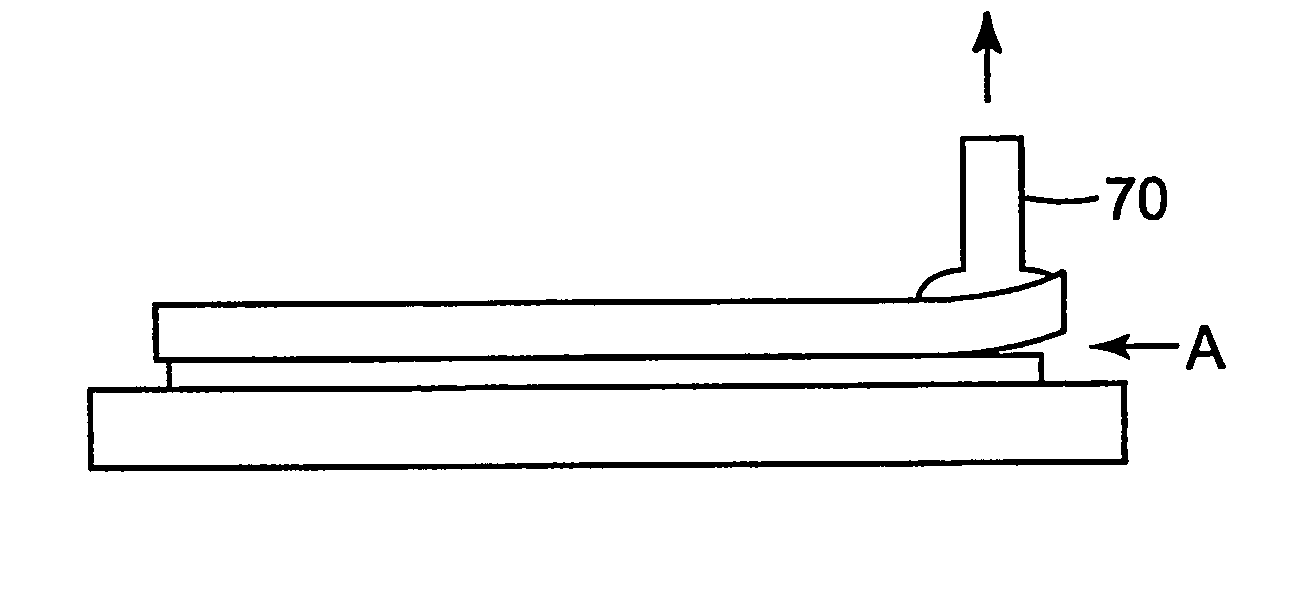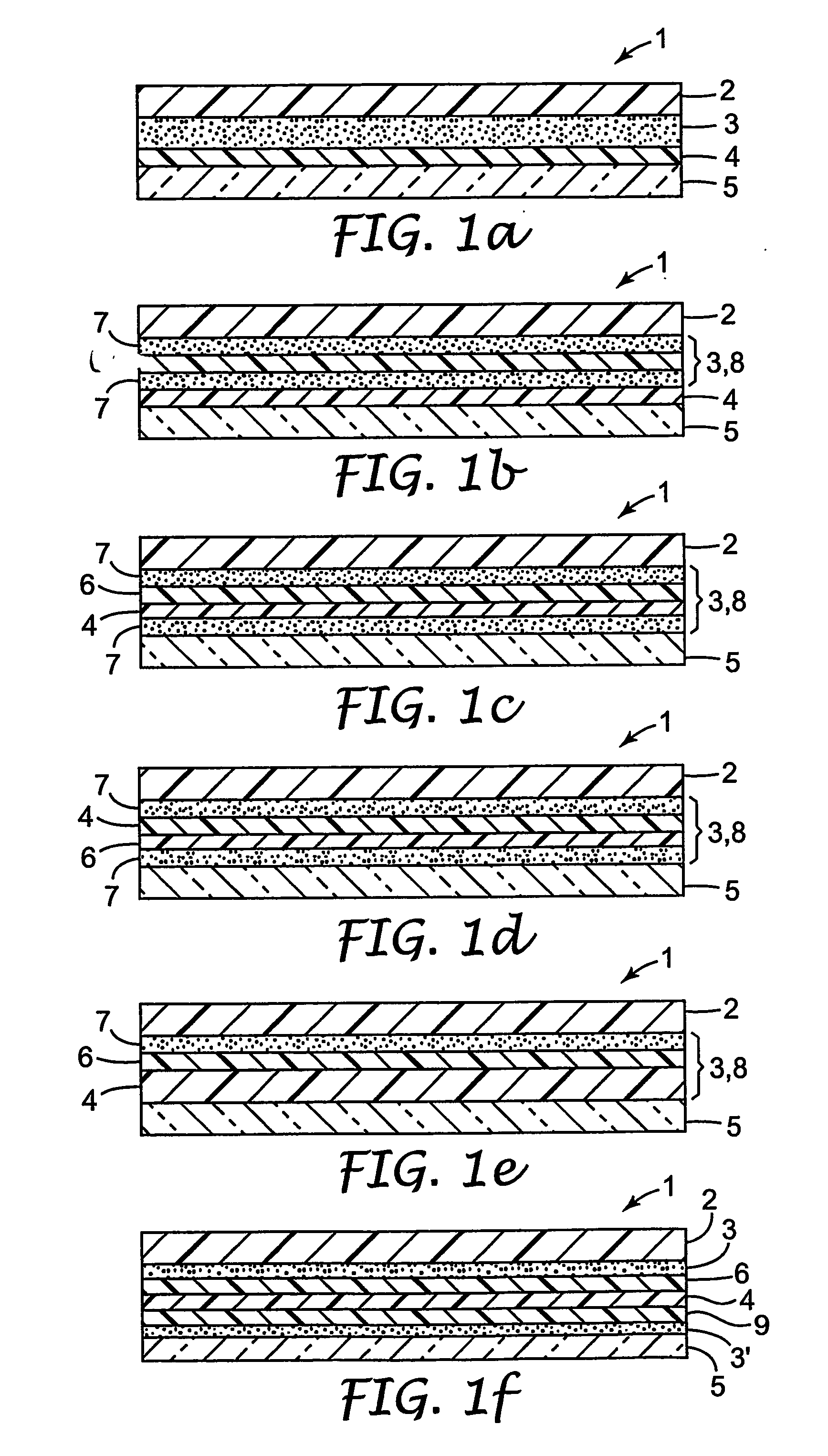Laminate body, method, and apparatus for manufacturing ultrathin substrate using the laminate body
a technology of laminate body and ultrathin substrate, which is applied in the direction of diffusion transfer process, photosensitive materials, instruments, etc., can solve the problems that the method cannot be practically used as a method of thinning a semiconductor wafer, and the method has not yet achieved a remarkable improvement over the present level of wafer thickness, etc., and achieves the effect of easy peeling
- Summary
- Abstract
- Description
- Claims
- Application Information
AI Technical Summary
Benefits of technology
Problems solved by technology
Method used
Image
Examples
example 1
[0085] A glass substrate of 220 mm (diameter)×1.0 mm (thickness) was used as the light permeable support, and a silicon wafer of 200 mm (diameter)×750 μm (thickness) was used as the wafer. A 10% solution (in propylene glycol methylether acetate solvent) of a photothermal conversion layer precursor having the composition shown in Table 1 above was coated on the glass substrate by spin coating. This was dried by heating and then cured by ultraviolet (UV) irradiation to form a photothermal conversion layer on the support. A joining layer precursor having the composition shown in Table 2 above was coated on the wafer similarly by spin coating. The glass substrate and the wafer were laminated to each other in a vacuum adhesion device as shown in FIG. 2 and thereon, was irradiated with UV light to cure the joining layer precursor, thereby obtaining a laminated body. This laminated body had a configuration of glass substrate / photothermal conversion layer / joining layer / silicon wafer, the th...
example 2
[0089] In this Example, the test was performed in the same manner as in Example 1 except for the following modifications. As the photothermal conversion layer precursor, a 20% solution (in propylene glycol methylether acetate) having the composition at a solid content ratio shown in Table 3 below was used. Furthermore, in order to prevent re-adhesion due to the weight of the glass substrate during laser irradiation, an L-shaped hook was inserted into the edge part of the glass substrate and hung up with a spring, whereby re-adhesion due to the weight of the glass substrate during laser beam irradiation was prevented. Similarly to Example 1, a silicon wafer having a thickness of 50 μm could be obtained without damaging the wafer.
TABLE 3Photothermal Conversion LayerSolid Content RatioRaven 76027.64%Disperbyk 16113.82%Ebecryl 880450.49%Irgacure 369 7.00%Irgacure 184 1.05%Total100.00%
Raven 760 (Columbian Carbon Japan Ltd.): carbon black; Disperbyk 161 (BYK Chemie): dispersant (30% in...
example 3
[0090] In this Example, the test was performed in the same manner as in Example 2 except that a 10% solution (in propylene glycol methylether acetate) having the composition at a solid content ratio shown in Table 4 below was used as the photothermal conversion layer precursor. This photothermal conversion layer precursor is a polymer solution containing carbon black and therefore, the photothermal conversion layer was formed only by drying.
TABLE 4Photothermal Conversion LayerSolid Content RatioRaven 76030.06%Disperbyk 16115.03%UR830054.91%Total100.00%
Raven 760 carbon black; Disperbyk 161 dispersant; UR8300 polyurethane polyester.
[0091] A silicon wafer having a thickness of 50 μm could be obtained without damaging the wafer by the same operation similarly to Example 1.
PUM
| Property | Measurement | Unit |
|---|---|---|
| transparent | aaaaa | aaaaa |
| thickness | aaaaa | aaaaa |
| thickness | aaaaa | aaaaa |
Abstract
Description
Claims
Application Information
 Login to View More
Login to View More - R&D
- Intellectual Property
- Life Sciences
- Materials
- Tech Scout
- Unparalleled Data Quality
- Higher Quality Content
- 60% Fewer Hallucinations
Browse by: Latest US Patents, China's latest patents, Technical Efficacy Thesaurus, Application Domain, Technology Topic, Popular Technical Reports.
© 2025 PatSnap. All rights reserved.Legal|Privacy policy|Modern Slavery Act Transparency Statement|Sitemap|About US| Contact US: help@patsnap.com



